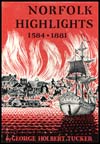Chapter 39
Alexander Galt -- The Sculptor from Norfolk
Alexander Galt, one of the best-known American sculptors of his day, was Norfolk's first bid for national artistic fame.
Born in Norfolk on January 26, 1827, Galt was a son of Alexander Galt Sr., Norfolk's postmaster at that time. His artistic talents were first noticed when he was a pupil of a Frenchman, M. Schisano, whose school was a well-known Norfolk institution of its day.
Galt's first efforts at sculpture were miniature figures carved from pieces of chalk he carried in his pockets to chalk the taws he used when shooting marbles with his schoolmates. From these he progressed to small alabaster figures, after which he began carving cameos from conch shells, several of which were set in gold and worn by Norfolk belles of that era.
Galt's talents continued to develop rapidly, and when he was twenty-one he realized his boyhood ambition of going to Florence, Italy, to study sculpture.
By 1853, when he was twenty-six, Galt was an established sculptor, and the two works he exhibited at the Crystal Palace exhibition in New York of that year attracted considerable attention. One of these, an allegorical marble bust called "Virginia," was purchased for two hundred and fifty dollars by the Art Union of New York.
Galt's principal work, and the one by which he is best remembered today, was a life-size marble statue of Thomas Jefferson commissioned by the Virginia General Assembly in 1854 as a gift to the University of Virginia. Upon completion, the statue, for which Galt received ten thousand dollars, was brought back to Richmond, where it was exhibited against a scarlet cloth background illuminated with gaslights.
After the Civil War, it was placed in the Rotunda of the University where it remained until 1895, when the building was damaged by fire. After the restoration of the building, it was returned to its former place of honor.
An ardent Southerner, Galt sided with his native Virginia at the outbreak of the Civil War. In 1862, when he was visiting Stonewall Jackson's camp to take measurements of the general for a proposed statue, he contracted smallpox. He died early in 1863 in Richmond and was buried in Hollywood Cemetery there.
Fortunately, his correspondence, sketchbooks, diaries, and other papers were carefully preserved by his family and are now in the library of the University of Virginia.
Romantically classical by temperament, Galt drew his inspiration from ancient Greece and Rome. One of his works, an ideal bust of Sappho, has an interesting story.
Commissioned by the Norfolk-born Virginia historian Hugh Blair Grigsby, the bust was shipped from Italy to New York early in 1861.
The Civil War had begun when it arrived, and as it was Southern property, it was confiscated and sold to J. Nelson Tappan, a wealthy New York merchant.
After the war, Grigsby went to New York in search of the bust, and when he discovered it and presented Tappan with the evidence that he was the rightful owner, the New Yorker graciously turned it over to him, refusing any remuneration.
The bust was then shipped to Norfolk, where Grigsby installed it in the drawing room of his halfbrother, the banker, John B. Whitehead, where it was acclaimed the finest art work in the city until Grigsby sent it to his country home in Charlotte County.
Chapter
40
Other Notable Buildings and Houses
Norfolk Highlights 1584 - 1881

See the "Table of Contents" for links to every chapter in Norfolk Highlights 1584 - 1881 by George Holbert Tucker.
